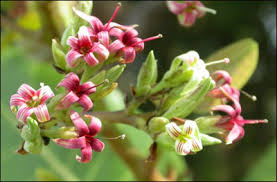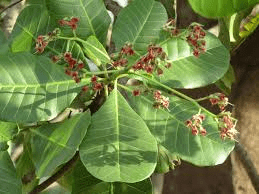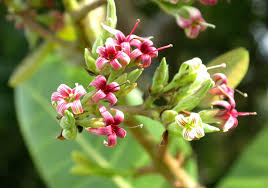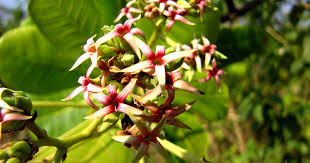Cashew flowers are the reproductive structures of the cashew tree (Anacardium occidentale), which produce both the cashew nut (seed) and the cashew apple (fruit). These flowers play a vital role in the plant’s reproductive process and eventual fruit formation.
Cashew flowers typically bloom in clusters and are small in size, with delicate petals that can range in color from pale green to yellowish-white. They emerge from the branches of the cashew tree, usually in response to seasonal changes or environmental cues.
The cashew flower is a perfect flower, meaning it contains both male and female reproductive organs. The male reproductive organs, called stamens, produce pollen, while the female reproductive organ, called the pistil, contains the stigma, style, and ovary.
Pollination of cashew flowers can occur through various means, including wind, insects, or manual intervention. Once pollinated, the pollen grains travel from the stamen to the stigma, where they germinate and form pollen tubes that grow down through the style to reach the ovary.
Fertilization occurs when the male gametes (sperm cells) from the pollen grains unite with the female gametes (egg cells) within the ovary, resulting in the formation of seeds. These seeds develop into the cashew nuts, which are attached to the bottom of the cashew apple.
After fertilization, the cashew flower undergoes senescence, and the ovary begins to develop into the cashew apple, while the fertilized ovules within the ovary mature into cashew nuts. Eventually, the cashew apple ripens, and the nuts reach maturity, signaling that they are ready for harvest.
Overall, cashew flowers are essential for the reproductive cycle of the cashew tree, leading to the formation of both the cashew nut and the cashew apple, which are valued for their culinary and commercial significance. Understanding the biology and development of cashew flowers is crucial for optimizing cashew production and ensuring successful fruit yield.
The Economic Importance and Uses of Cashew Flowers

1. Pollination: Cashew flowers play a crucial role in pollination, facilitating the reproduction of cashew trees and ensuring fruit set, which is essential for cashew nut production.
2. Cashew Nut Production: Cashew flowers give rise to cashew nuts, a valuable agricultural commodity traded globally for culinary, nutritional, and industrial uses.
3. Honey Production: Bees pollinate cashew flowers and produce honey from the nectar, contributing to the apiculture industry and providing additional income sources for beekeepers.
4. Agroforestry: Cashew flowers enhance biodiversity and ecosystem services in agroforestry systems, supporting soil fertility, water retention, and microclimate regulation.
5. Landscape Ornamentation: Cashew flowers adorn landscapes with their vibrant colors and attractive blooms, enhancing aesthetic appeal in gardens, parks, and urban green spaces.
6. Cultural Significance: Cashew flowers hold cultural significance in various societies, symbolizing fertility, abundance, and prosperity, and featuring in religious rituals, festivals, and ceremonies.
7. Ecotourism: Cashew flowers attract tourists interested in ecotourism experiences, offering opportunities for flower viewing, nature walks, and agricultural tours in cashew-growing regions.
8. Research and Education: Cashew flowers are studied for their morphology, physiology, and reproductive biology, contributing to scientific knowledge, agricultural research, and educational programs.
9. Medicinal Uses: Traditional medicine practices utilize extracts from cashew flowers for various medicinal purposes, including treating inflammation, fever, and respiratory ailments.
10. Perfumery: Cashew flower extracts are used in perfumery and cosmetics for their aromatic properties, adding floral notes to fragrances, lotions, and skincare products.
11. Culinary Decoration: Cashew flowers are used as edible decorations in culinary presentations, garnishing dishes, desserts, and beverages with their delicate petals and vibrant colors.
12. Floral Arrangements: Florists incorporate cashew flowers into floral arrangements, bouquets, and centerpieces for weddings, events, and special occasions, adding a tropical touch to floral designs.
13. Seed Production: Cashew flowers produce seeds, which can be collected and propagated to establish new cashew orchards, supporting agricultural expansion and rural development.
14. Wildlife Habitat: Cashew flowers attract pollinators such as bees, butterflies, and birds, providing habitat and forage resources for diverse wildlife species in agroecosystems.
15. Climate Resilience: Cashew flowers contribute to climate resilience in agricultural systems by adapting to environmental stressors such as drought, heat, and fluctuating temperatures.
16. Seed Banks: Cashew flowers contribute to seed banks and germplasm repositories, preserving genetic diversity and heritage varieties for future breeding and conservation efforts.
17. Soil Conservation: Cashew flowers enhance soil conservation measures by promoting soil aggregation, erosion control, and organic matter decomposition in agroforestry landscapes.
Read Also: 10 Medicinal Health Benefits Of Banisteriopsis caapi (Ayahuasca)
The Products and By-products That Can Be Derived From Cashew Flowers

1. Cashew Nuts: Cashew flowers give rise to cashew nuts, which are harvested, processed, and sold as raw nuts or further processed into various products such as snacks, confectionery, and culinary ingredients.
2. Honey: Bees pollinate cashew flowers and produce honey from the nectar, which is harvested and marketed as a natural sweetener and nutritional supplement.
3. Perfume: Cashew flower extracts are used in perfumery and cosmetics for their floral fragrance, adding aromatic notes to perfumes, colognes, and personal care products.
4. Medicinal Extracts: Extracts from cashew flowers are used in traditional medicine practices for their anti-inflammatory, antipyretic, and expectorant properties, treating various ailments and health conditions.
5. Culinary Decorations: Cashew flowers are used as edible decorations in culinary presentations, garnishing dishes, desserts, and beverages with their vibrant colors and delicate petals.
6. Floral Arrangements: Florists incorporate cashew flowers into floral arrangements, bouquets, and centerpieces for weddings, events, and special occasions, adding a tropical touch to floral designs.
7. Seedlings: Cashew flowers produce seeds, which can be collected and used to propagate seedlings for establishing new cashew orchards and expanding agricultural production.
8. Herbal Tea: Dried cashew flowers are used to brew herbal tea, which is consumed for its soothing aroma and potential health benefits, such as relaxation and digestion aid.
9. Aromatic Potpourri: Dried cashew flowers are used in potpourri blends, adding fragrance and visual appeal to home decor and aromatherapy applications.
10. Soil Amendments: Cashew flower residues, such as fallen petals and spent blooms, can be composted and used as organic soil amendments to improve soil structure and fertility in agricultural and horticultural settings.
Read Also: 8 Steps to Successful Perennial Pasture Establishment
Frequently Asked Questions (FAQ’s) About Cashew Flowers

1. Do cashew flowers produce cashew nuts directly?
Yes, cashew flowers give rise to cashew nuts, which develop after successful pollination and fertilization of the flowers’ ovules. The nuts grow attached to the cashew apple.
2. Are cashew flowers fragrant?
Yes, cashew flowers are fragrant and emit a mild, pleasant aroma during blooming. Their fragrance attracts pollinators such as bees, butterflies, and birds.
3. Can cashew flowers be used in cooking?
While cashew flowers are not typically used in cooking, their delicate petals can be consumed as edible decorations in culinary presentations, garnishing dishes, desserts, and beverages.
4. How long do cashew flowers bloom?
Cashew flowers typically bloom for a few days to a week, depending on environmental conditions such as temperature, humidity, and sunlight. Peak flowering usually occurs during the cashew tree’s flowering season.
5. Do cashew flowers attract bees?
Yes, cashew flowers attract bees and other pollinators with their nectar and fragrance. Bees play a crucial role in pollinating cashew flowers, facilitating fruit set and cashew nut production.
6. Can cashew flowers be harvested for any products?
While cashew flowers themselves are not harvested for products, their presence is essential for cashew nut production, honey production, and ecosystem services such as pollination and biodiversity support.
7. Are cashew flowers used in traditional medicine?
Yes, extracts from cashew flowers are used in traditional medicine practices for their medicinal properties, which include anti-inflammatory, antipyretic, and expectorant effects.
8. Do cashew flowers have any cultural significance?
Cashew flowers hold cultural significance in various societies, symbolizing fertility, abundance, and prosperity. They may feature in religious rituals, festivals, and ceremonies in cashew-growing regions.
9. Can cashew flowers be dried or preserved?
While cashew flowers can be dried for decorative purposes, their delicate nature may make preservation challenging. Dried cashew flowers are sometimes used in potpourri blends and herbal teas.
10. Do cashew flowers have any environmental benefits?
Yes, cashew flowers contribute to ecosystem services such as pollination, biodiversity support, and soil conservation, enhancing environmental sustainability in agricultural landscapes.
Read Also: Practical Steps to Convert Printer Cartridges Wastes into Plastic Products

